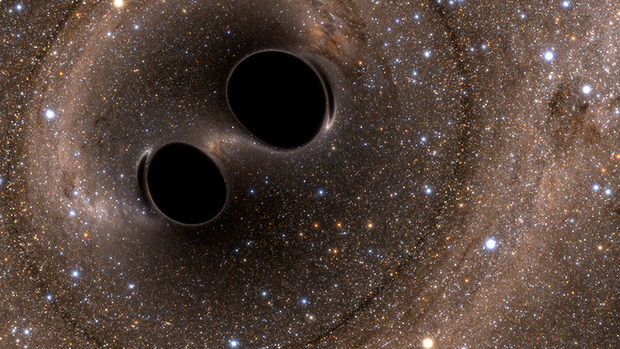

| Online: | |
| Visits: | |
| Stories: |

| Story Views | |
| Now: | |
| Last Hour: | |
| Last 24 Hours: | |
| Total: | |
Scientists Chase Colliding Black Holes
This week the advanced LIGO facility in the USA announced that they had detected Gravitational Waves from a merging binary black hole for the second time.
Within hours of this discovery on 26 December, scientists from the University of Leicester and an international team used the Swift satellite to search for associated X-ray and ultra-violet emission.Numerical simulation of two merging black holes performed by the Albert Einstein Institute in Germany: what this rendition shows through colors is the degree of perturbation of the spacetime fabric, the so-called gravitational waves.

Credit: Werner Benger.
“Despite it being the middle of the holidays, we were able to respond very quickly,” recalls Dr Phil Evans of the University of Leicester, who coordinates the Swift response to Gravitational Wave events. “And we had modified our approach, so we could search nearly twice as much sky with Swift following the Boxing Day event than we had for the previous LIGO detection in September.”
This visualization shows gravitational waves emitted by two black holes of nearly equal mass as they spiral together and merge. Orange ripples represent distortions of space-time caused by the rapidly orbiting masses. These distortions spread out and weaken, ultimately becoming gravitational waves (purple). Black spheres represent the black hole event horizons, surfaces beyond which nothing can escape. The merger timescale depends on the masses of the black holes.
The team found no sign of the merging stars with Swift, nor with the VISTA telescope in Chile, which performed observations 7-13 days after the trigger. This is in itself a result. “There is a lot of debate at the moment about whether we should expect to see electromagnetic radiation from merging black holes,” explained University of Leicester Professor, Nial Tanvir, “so finding nothing can be an important result.”
However, the large uncertainty in where the gravitational wave event occurred makes it hard to be sure whether the astronomers looked in the right place. “It really is like searching for a needle in a haystack,” Professor Julian Osborne admitted, but the Swift team has ways of narrowing down where to look. “Black holes occur in galaxies, and LIGO can only detect cosmically nearby events. So we only observe where we know there are nearby galaxies; this can shrink the search area by as much as 5 or 6 times.”

Image credit: The SXS (Simulating eXtreme Spacetimes) Project
Later this year a second gravitational wave observing run will start, with the European advanced VIRGO facility expected to join advanced LIGO. Scientists hope for the first gravitational discovery of merging neutron stars with the resulting improved sensitivity and precision. “We may still be debating whether merging black holes produce light, but we are pretty certain that merging neutron stars do,” commented Professor Paul O’Brien, head of the department of Physics & Astronomy at the University of Leicester. “Detecting both light and gravitational waves from the same event would be of huge scientific value.”
But will the Swift team be able to find such light, given the size of the haystack they have to search? Dr Evans is confident that they will: “We’ve recently enabled a new observing mode, which will let us cover something like ten times as much sky for future events than we’ve been able to do so far,” he said. “In the future we can simultaneously shrink the haystack, identify which bits are most likely to contain the needle, and search through it more rapidly.”
Dr Phil Evans
The research paper “Swift follow-up of gravitational wave triggers: results from the first aLIGO run and optimization for the future” by Evans et al. has been submitted for publication to Monthly Notices of the Royal Astronomical Society.http://www.star.le.ac.uk/~pae9/O2.pdf
The second gravitational wave detection of a pair of merging black holes by advanced LIGO is described athttps://www.ligo.caltech.edu/news/ligo20160615
Source:


